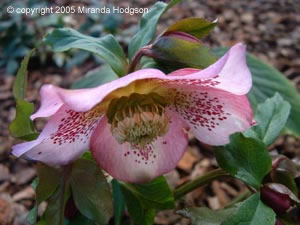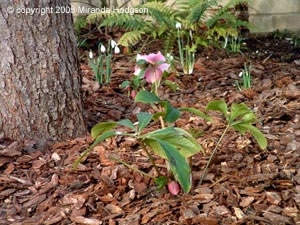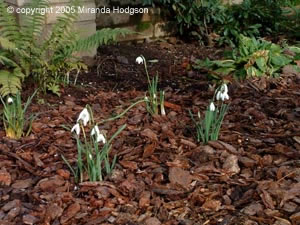Feb 7th 2005 - Watch your head!
First things first – I passed the mock exam. Hurrah! Not as well as I might have done because I made a couple of stupid mistakes by leaving out some key information in the long questions. But that’s what mock exams are for, to help you sort all that out before the Big Day. Really need to get down to some serious swotting now.

"...Deliberately damaging the stem encourages the plant to repair itself "
An interesting day at college this week. The practical session was on air layering, which is one of the first techniques I learned and carried out on a rubber plant many years ago. Rather than removing a stem from the plant and potting it separately, a stem is cut, or a small section of bark is removed, and then the stem is wrapped in damp moss and covered with black polythene for up to six months until roots form.
Deliberately damaging the stem encourages the plant to repair itself by putting out new roots. When these have formed the stem is cut from the main plant and potted up.
"...An odd picture we must have presented and I couldn’t help noticing visitors to the garden looking..."
The plants we worked on were part of a large and unruly group of Rhododendrons growing amongst trees at Normanby Hall. We worked in pairs, clambering around the serpentine branches of the Rhododendrons to get the just the right stems, greening our clothes, getting ourselves tangled and dropping knives.
An odd picture we must have presented and I couldn’t help noticing visitors to the garden looking very much askance as we giggled amongst the low growing branches. Not sure why it should have been funny, but we all enjoyed it immensely.
The prime air layering material for Rhododendrons is healthy young growth of pencil thickness. First find a leaf node where the leaf has fallen off. Just below this, wrap a small sheet of black polythene around the stem and fix it at the bottom with a cut elastic band which is tied into a knot (this is why we worked in pairs – it’s much easier with four hands). Next make a shallow cut, 2-3cm long, upwards into the bark. A few shreds of damp moss are then dusted with rooting hormone and gently inserted into the cut with a knife blade, while the rest of the moss is pressed around the stem in a ball.
The plastic is then wrapped around the moss ball and secured at the top with another elastic band. It ends up looking a bit like a giant wrapped sweetie.
This will prevent the plant developing any fungal or disease problems
All being well, the stems will have rooted by the autumn and we should all try to visit, check them and remove the cuttings. This will prevent the plant developing any fungal or disease problems that could result from having polythene left wrapped around the stem.
Taking plant material from Normanby Hall without permission is considered to be theft so I’m not sure what we’re supposed to do with them once we remove them from the plant. I don’t like Rhododendrons myself, and they’re not popular with other class members.
They’re invasive, take up a huge amount of space and don’t get along with ground cover plants
They’re invasive, take up a huge amount of space and don’t get along with ground cover plants, herbaceous plants or heathers. I also doubt whether the head gardener, Sue Hoy, will be particularly interested in propagating them. It’s likely they’ll simply end up as martyrs to our learning experience.
This last week has seen the woodland edge area under the tree finished and we’re both very pleased with it. The weather has been cool and fairly dry, ideal for the heavy work of turf lifting. Gail’s turf lifter is a brilliant device and the turf came up easily in thin layers, without damaging the tree’s roots. Once it was gone, the soil was gently loosened and a dressing of blood, fish and bone meal put down and raked in.

Deciding where to put the plants was awkward, that kind of thing always is, but I eventually settled on a pattern. There are three Cyclamen coum planted together, three Hellebores and a larger grouping of Galanthus nivalis.
"...every other time I stood up straight I cracked my head on a low branch"
The plants don’t cover much ground yet but will fill out over time. Once they were planted, a good thick layer of small bark chips went down all around them, to discourage seed germination, and a log was strategically placed for sitting on, should either of us ever get the opportunity to do that.
The only down side to creating this woodland edge area is the current tenderness of my poor abused skull. It seemed that every other time I stood up straight I cracked my head on a low branch and now I can feel several sore spots on my head. It was sheer luck when I managed to straighten up into areas that were branch-free.

Just as well we don’t have a cuss box or it would be getting heavy. It should be pretty obvious when you’re working under a tree that there are low branches and that if you’re not careful you’ll bang your head on them but, somehow, I managed to not think about that.
There’s suddenly a lot more bird activity in the garden. It looks like the robin has chosen a mate as we’ve been seeing a stranger in the garden and it isn’t being chased away. The two of them have been doing little hoppy dances for each other, a delight to see.
"...a young male blackbird which has been spending long periods standing under shrubs singing very quietly to itself."
The blue tits are investigating the nesting boxes so there’s a good chance we’ll see them raise a family, as they did last year. I don’t know if it will be the same birds, of course, but it is said that blue tits will return to a nesting site the following year.
We’ve been watching a young male blackbird which has been spending long periods standing under shrubs singing very quietly to itself.
When I first heard it, it took me a while to work out where it was but after looking about I spotted it hidden away under a Choisya ternata. The song was beautiful, a low, fluty, richly varied tune. The robin also sings a sort of sub-song and I’ve read that they may be practicing their repertoires, ready for announcing them to the other birds.
© Copyright Miranda Hodgson 2005